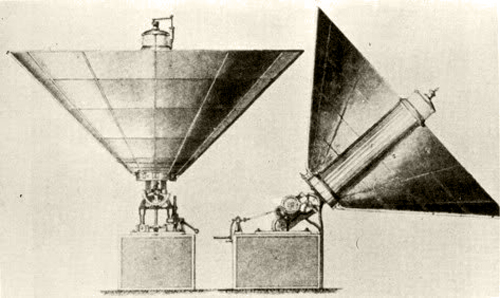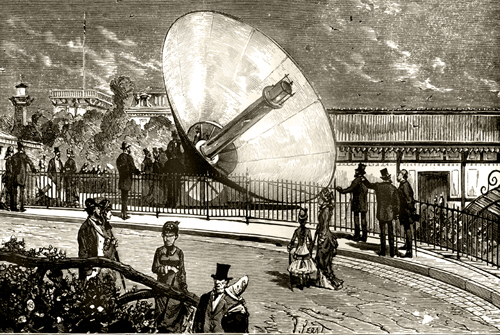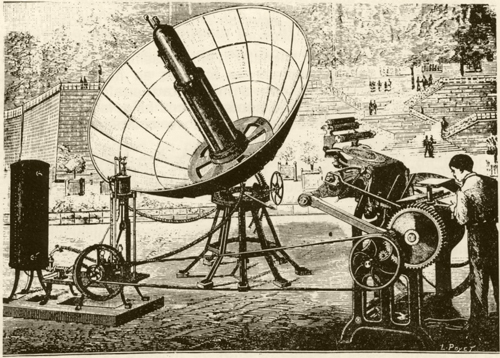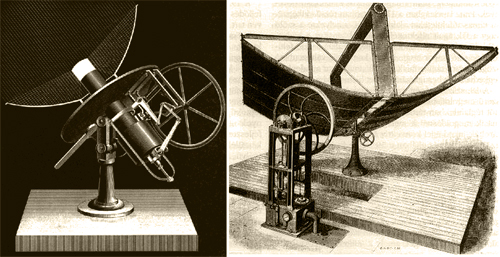
Augustin Mouchot’s Solar Concentrator, 1869. (source)
The history of renewable energy is fascinating. We posted a while back about early efforts to harness the power of waves. You may also be interested to learn more about the 19th century work of Mouchot and Ericsson, early pioneers of solar thermal concentrators (CSP solar thermal power).

Early schematics of Augustin Mouchot’s Solar Concentrator.
Augustin Mouchot taught secondary school mathematics from 1852-1871, during which time he embarked on a series of experiments in the conversion of solar energy into useful work. His proof-of-concept designs were so successful that he obtained support from the French government to pursue the research full-time. His work was inspired and informed by that of Horace-Bénédict de Saussure (who had constructed the first successful solar oven in 1767) and Claude Pouillet (who invented the Pyrheliometer in 1838).

Augustin Mouchot’s Solar Concentrator at the Universal Exhibition in Paris, 1878. (source)
Mouchot worked on his most ambitious device in the sunny conditions of French Algeria and brought it back for demonstration at the Universal Exhibition in Paris of 1878. There he won the Gold Medal, impressing the judges with the production of ice from the power of the sun.
Unfortunately, the falling price of coal, driven by efficiencies of transport and free trade agreements with Britain, meant that Mouchot’s work would soon be deemed unnecessary and his funding was cut soon after his triumph at the Universal Exhibition.

Abel Pifre and his solar powered printing press. Image from Scientific American, May 1882. (source)
His assistant, Abel Pifre, would continue his work, however, and demonstrated a solar powered printing press in the Jardin des Tuileries in 1882. Despite cloudy conditions that day, the machine printed 500 copies per hour of Le Journal du Soleil, a newspaper written specially for the demonstration.

John Ericsson’s Solar Engines. (left image source, right image source)
Meanwhile, the great inventor and engineer John Ericsson had decided to devote the last years of his life to similar pursuits. His work on solar engines spanned the 1870s and 1880s. Instead of relying on steam, he utilized his version of the heat engine, a device that would prove very commercially successful when powered with more conventional fuel sources such as gas.
From Paul Collins’ 2002 essay The Beautiful Possibility:
“You will probably be surprised when I say that the sun-motor is nearer perfection than the steam-engine,” [Ericsson] wrote one friend, “but until coal mines are exhausted its value will not be fully acknowledged.” He calculated that solar power cost about ten times as much as coal, so that until coal began to run out, solar power would not be economically feasible. But this, to him, was not a sign of failure—there was no question that fossil fuels would indeed run out someday.
The great engineer maintained an unshakeable belief in the future of solar power to his last breath; he had set up a large engine in his backyard and was still perfecting it when he collapsed in early 1889. Though his doctor made him rest, Ericsson could not sleep at night: he complained that he could not stop thinking about his work yet to be done.
Both Mouchot and Ericsson were driven by the prescient understanding that access to coal, the predominant fossil fuel of the time, would eventually run out. And while, new discoveries of petroleum and natural gas have extended our inexpensive access to energy, we are finally now, 140 years later, reaching a time when their predictions are coming true. For the wisdom behind the premise is still as valid today as it was then—nothing that is finite can last forever. These inventors were so far ahead of their time, it is almost scary.
Related Posts
21 Comments
Add comment Cancel reply
This site uses Akismet to reduce spam. Learn how your comment data is processed.


[…] with that? You can read more about his experiments, and the subsequent machines he inspired, at Land Art Generator, although I found the image on Wikimedia Commons and read more about the technology on Swedish […]
[…] Mouchet and his helper Abel Pifre, who would construct the first solar-powered printing press, showed their solar-powered engine at the Universal Exhibition in Paris in 1878, winning a gold medal. Mouchet’s work, unfortunately, was ahead of its time. […]
[…] http://landartgenerator.org/blagi/archives/2004 […]
[…] February 29, 2012 , In Solar Power, with permission from LANDGENERATOR […]
[…] Mouchot and Abel Pifre, the first solar power printing press, 1882. Photo: Le petit […]
[…] Mouchot and Abel Pifre, the first solar power printing press, 1882. Photo: Le petit […]
[…] Mouchot and Abel Pifre, the first solar power printing press, 1882. Photo: Le petit […]
[…] Augustin Mouchot, a 19th-century French inventor most known for his work in mathematics and physics, invented an engine that converted solar energy to mechanical energy at the Universal Exposition in Paris. […]
[…] http://www.bpb.de/apuz/59680/eine-kurze-geschichte-der-deutschen-antiatomkraftbewegung?p=all http://landartgenerator.org/blagi/archives/2004 […]
[…] landartgenerator.org […]
[…] of the earliest successful demonstrations of solar technology happened at the Universal Exhibition in Paris (1878). There, Augustin Mouchot […]
[…] “The 19th Century Solar Engines of Augustin Mouchot, Abel Pifre, and John Ericsson,” Land Art Generator […]
[…] Concentrador solar de Mouchot. Fuente. […]
[…] Concentrador solar de Mouchot. Fuente. […]
[…] really interesting work was going on in this field back in the 1800′s. It may be time to pick up where they left […]
[…] been running in California for 20 years. Going back further, you could point to the French inventor Agustin Mouchot, who experimented with solar powered steam engines in the 19th century, thinking we were about to […]
[…] been running in California for 20 years. Going back further, you could point to the French inventorAgustin Mouchot, who experimented with solar powered steam engines in the 19th century, thinking we were about to […]
[…] been running in California for 20 years. Going back further, you could point to the French inventorAgustin Mouchot, who experimented with solar powered steam engines in the 19th century, thinking we were about to […]
[…] been running in California for 20 years. Going back further, you could point to the French inventor Agustin Mouchot, who experimented with solar powered steam engines in the 19th century, thinking we were about to […]
[…] been running in California for 20 years. Going back further, you could point to the French inventor Agustin Mouchot, who experimented with solar powered steam engines in the 19th century, thinking we were about to […]
[…] been running in California for 20 years. Going back further, you could point to the French inventor Agustin Mouchot, who experimented with solar powered steam engines in the 19th century, thinking we were about to […]